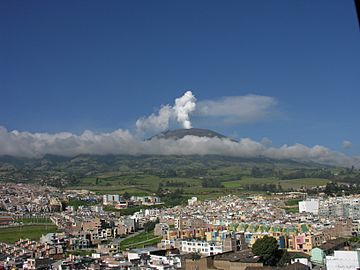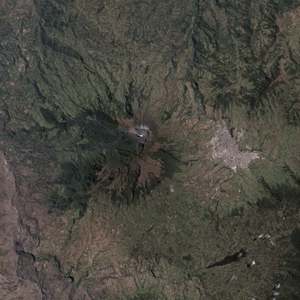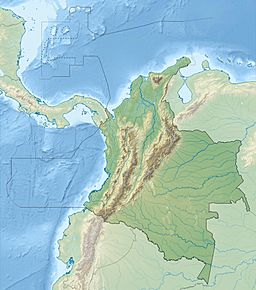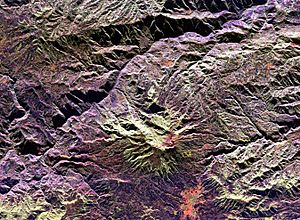Galeras facts for kids
Quick facts for kids Galeras |
|
|---|---|

Galeras in December 2005
|
|
| Highest point | |
| Elevation | 4,276 m (14,029 ft) |
| Geography | |
| Location | Nariño |
| Parent range | Central Ranges Andes |
| Geology | |
| Mountain type | Complex volcano |
| Volcanic arc/belt | North Volcanic Zone |
| Last eruption | 2012 to 2014 |
Galeras is a large volcano in Colombia, South America. It is located in the Nariño region, close to the city of Pasto. This volcano is part of the Andes mountain range.
Galeras is very tall, reaching about 4,276 meters (14,029 feet) above sea level. It has erupted many times throughout history. The first eruption recorded by people was on December 7, 1580. Today, Galeras is known as the most active volcano in Colombia.
Contents
How Galeras Was Formed
Galeras has been an active volcano for at least one million years. It mainly produces a type of volcanic rock called andesite.
Over time, Galeras had two very big eruptions. The first one happened about 560,000 years ago. It shot out a huge amount of material, about 15 cubic kilometers! This eruption created a large bowl-shaped hollow called a caldera.
The second big eruption was between 40,000 and 150,000 years ago. This one was smaller, but still powerful, releasing about 2 cubic kilometers of material. After this, part of the caldera wall collapsed. This might have happened because hot water activity made the ground unstable.
Since then, new eruptions have built a smaller cone inside the caldera. This makes the caldera look like a horseshoe shape now.
Because Galeras has a history of strong eruptions and is close to Pasto (a city with about 450,000 people), it was named a "Decade Volcano" in 1991. This means it was chosen for special study by the United Nations. Scientists wanted to learn more about it to help protect people from natural disasters.
History of Eruptions
Galeras is the most active volcano in Colombia. Another active one is Nevado del Ruiz. Scientists have used radiocarbon dating to find out about its past eruptions. Some of the earliest known eruptions happened around 7050 BC.
Many eruptions have occurred since then. These often involve an explosion from the central opening of the volcano. Such explosions can cause dangerous pyroclastic flows (fast-moving hot gas and rock) or lahars (mudslides made of volcanic ash and water).
More recent eruptions have been recorded in:
- 1535
- December 1580
- July 1616
- 1641
- 1670
- 1754
- November 1796
- June 1823
- October 1828
- 1834
- October 1865
- July 1889
- 1891
- December 1923
- October 1924
- October 1932
- February 1936
- July 1947
- January 1950
- 1974
- February 1989
- January 1990
- January 1993
- March 2000
- June 2002
- July 2004
- November 2005
- October 2007
The 1993 Eruption
Galeras became active again in 1988 after being quiet for 10 years.
In 1993, a meeting about Decade Volcanoes was held in Pasto. On January 14, some scientists and tourists decided to go into the crater of Galeras. The volcano erupted unexpectedly while they were there. Sadly, six scientists and three tourists died.
This event was very sad and also taught scientists important lessons. A prediction had been made a few days before, based on some unusual activity seen on a seismograph (a tool that measures ground movement). However, this prediction was based on limited information. The tragedy showed how difficult and dangerous it can be to predict when a volcano will erupt. It also highlighted the importance of strict safety rules for volcano research.
Galeras in the 21st Century

Galeras has continued to be active, but at a low level. Sometimes, small explosions cause ash (tiny bits of volcanic rock) to fall on nearby towns. Scientists keep studying the volcano closely. They have gotten better at predicting its eruptions.
One sign that often comes before an eruption is a special type of ground tremor. Scientists call these "tornillo events." These tremors have happened before about 80% of the explosions at Galeras. The number of tornillo events also seems to be linked to how big the eruption will be.
In April 2002, more than 100 small tremors were felt during a major eruption. Luckily, no one was hurt and there was no damage.
In November 2005, an eruption forced about 9,400 people from nearby villages to leave their homes for safety. The city of Pasto, which is about 9 kilometers (5.6 miles) from the volcano, was covered in a layer of ash. People there had to wear goggles and face masks.
From March 2006, there were many small tremors and ash clouds. This led to three big explosive eruptions on July 12, 2006. These eruptions sent ash and gas 8 kilometers (5 miles) into the sky. Rocks and pyroclastic flows were reported in towns as far as 11.4 kilometers (7 miles) away. The Colombian government has often asked over 8,500 people in high-risk areas to move to temporary shelters. They hope to help these people find safer places to live permanently.
On January 17, 2008, Galeras erupted again. There were no reports of injuries or major damage right away. However, experts later confirmed that local TV towers were partly damaged.
On February 14, 2009, the volcano erupted around 7:10 PM local time. About 8,000 residents were evacuated. Again, there were no immediate reports of injuries or serious damage. Like in 2005, Pasto was covered in ash because of the wind direction. Local officials also had to shut down two water treatment plants near the volcano.
On March 13, 2009, Galeras erupted twice in one day. Ash fell on Pasto and other nearby towns. People were told to evacuate, but many reportedly did not. No injuries or damage were reported.
2010 Eruptions
On January 3, 2010, Galeras erupted again. This forced 8,000 people to evacuate. It was the tenth eruption of the volcano in the past year and the first of 2010. Colombian authorities said the volcano could stay active for weeks.
Galeras erupted once more on August 25, 2010. An ash plume was seen in the sky. This eruption was described as "non-explosive." Authorities raised an alert for nearby towns to be ready.
Scientists continue to monitor Galeras closely. The Deep Earth Carbon Degassing Project is one group that studies this volcano.
See also
 In Spanish: Volcán Galeras para niños
In Spanish: Volcán Galeras para niños



